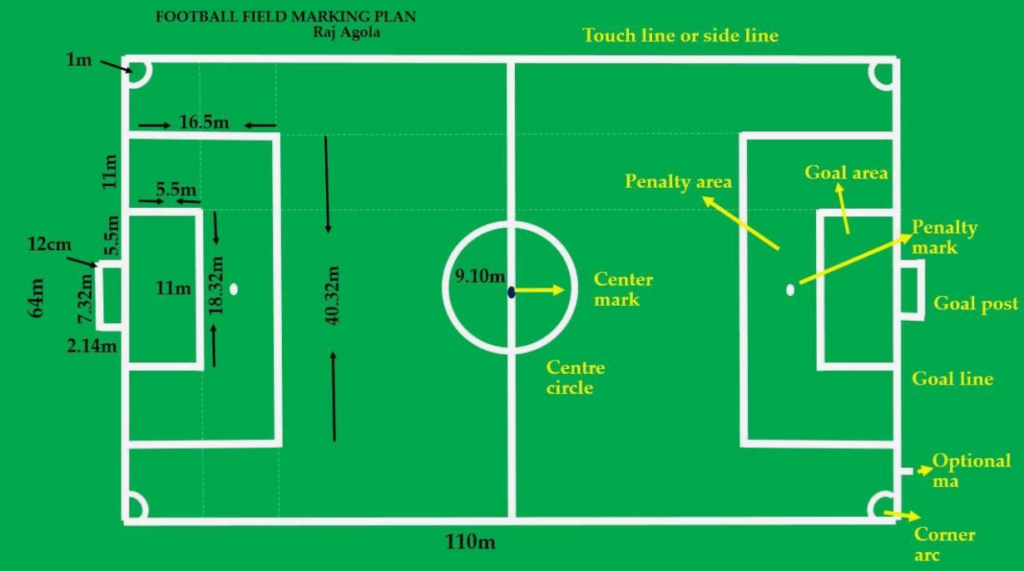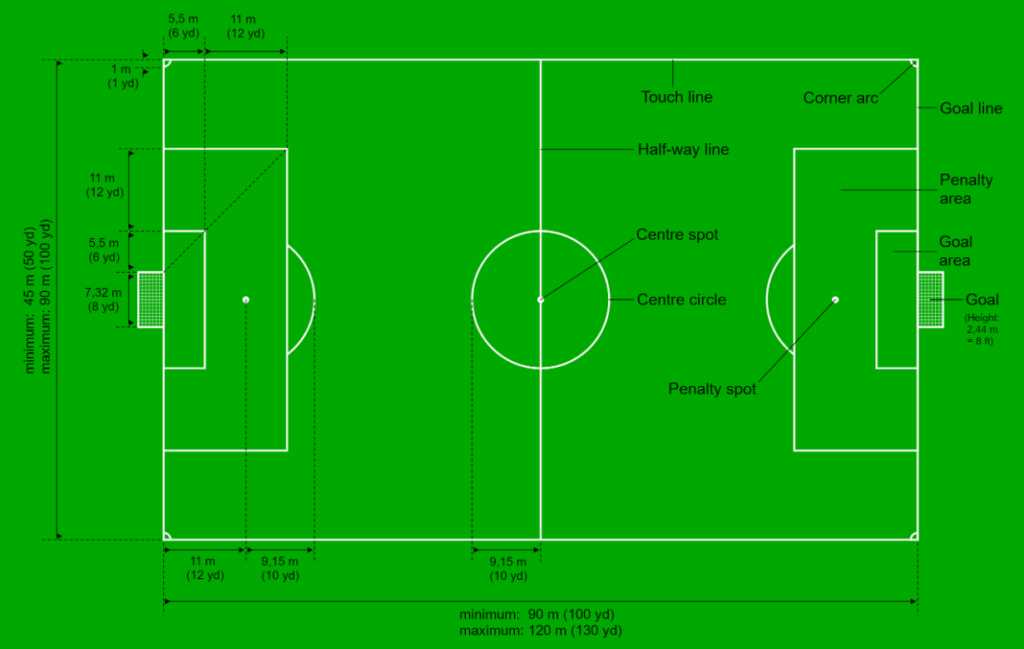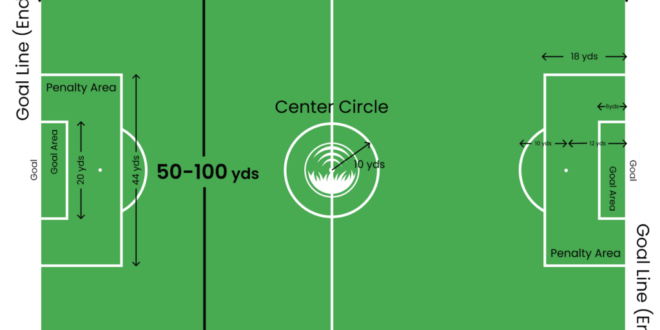A soccer field ranges in length from 100 to 130 yards. It must also be between 50 and 100 yards in width.
Understanding the dimensions of a soccer field is crucial for players, coaches, and fans alike. These measurements set the stage for international matches, local games, and everything in between. Soccer fields, also known as pitches, adhere to regulations set by the International Football Association Board (IFAB).
These dimensions ensure that the gameplay is fair and standardized across various levels of the sport. Both amateur and professional arenas must comply, though minor variations are permitted to accommodate different leagues and events. Official FIFA matches, for instance, often showcase fields on the larger end of the spectrum to facilitate professional play. Visitors to local sports complexes might encounter smaller pitches, reflecting community needs and space limitations. Understanding these variances helps appreciate the game’s adaptability to diverse playing environments.

Table of Contents
Field Dimensions: The Basics
Understanding the size of a soccer field is crucial, whether you’re a player, a coach, or a fan.
Minimums And Maximums
Soccer fields come in various sizes.
FIFA regulations stipulate certain minimums and maximums.
| Measurement | Minimum | Maximum |
|---|---|---|
| Length | 100 meters (110 yards) | 110 meters (120 yards) |
| Width | 64 meters (70 yards) | 75 meters (80 yards) |
Variations Across Leagues
Different leagues may have other standards.
- Major League Soccer (MLS) in the USA tends to use larger fields.
- European leagues like the English Premier League (EPL) often opt for a medium size.
- Smaller fields are commonly found in youth leagues to suit the children’s size.

Regulatory Standards
Regulatory standards play a crucial role in the world of soccer. They ensure fair play and uniformity across the globe. Understanding the dimensions of a soccer field is central to players, coaches, and fans alike. Fields must meet certain size criteria. Let’s explore the guidelines set by the major governing bodies of soccer.
Fifa And Ifab Guidelines
Two organizations, FIFA and IFAB, set the rules for soccer field dimensions. Their regulations are strict to maintain the game’s integrity. They specify that lengths should range from 100 to 110 meters, while widths should vary between 64 and 75 meters. These dimensions make the game fair and enjoyable for all participants. FIFA and IFAB ensure fields are consistent worldwide. This allows for a standard playing experience.
- Maximum Field Size: 110m x 75m
- Minimum Field Size: 100m x 64m
- International Matches: Fields may have narrower size ranges.
National Variations
While international guidelines are clear, national bodies can have different rules. In the United States, for instance, youth leagues often play on smaller fields. This is to account for the young players’ smaller strides. Adult amateur leagues might also have fields that don’t quite meet FIFA’s minimums. This is due to space constraints.
| Country | Regulation Range |
|---|---|
| USA (Youth Soccer) | Smaller than the FIFA minimum |
| USA (Adult Amateur) | Close to FIFA’s minimum |
| UK (Amateur) | Varies, often within FIFA range |
Soccer fields must fit within these guidelines to be considered regulation. The specific dimensions may vary, but the standards ensure the game’s quality. They are essential for a uniform playing field no matter where the game takes place.
Comparing Sizes
Football enthusiasts often wonder, how long is a soccer field? The size of a soccer field, also known as a pitch, can vary. The game’s laws specify minimum and maximum dimensions but fields can differ in size. This often depends on the level of play, from youth leagues to international competitions. Let’s kick off with comparisons between different field sizes within the world of soccer.
International Vs. Club Play
Fields for international matches have specific requirements. Fields in club play can be slightly different. Here’s a look at how they compare:
- International Matches: Length: 100m-110m, Width: 64m-75m
- Club Matches: Length: 90m-120m, Width: 45m-90m
International fields are standardized for fairness. Club fields can vary more because there’s less regulation.
Youth vs. Adult Soccer Fields
Youth Vs. Adult Soccer Fields
Soccer fields for youth are smaller than adult fields to match their needs and skills. Let’s compare the two:
| Category | Length | Width |
|---|---|---|
| Youth | 30m-90m | 15m-45m |
| Adult | 90m-120m | 45m-90m |
For younger players, smaller fields make the game more manageable and fun. Adult fields must meet regulation sizes for formal competition.

Lines And Markings
If you’ve ever watched a soccer match, you’ve noticed the crisp white lines crisscrossing the green field. These lines and markings are essential, guiding players and officials throughout the game. Each marking has a specific role, dictating everything from where players can take a penalty to how far spectators must stay from the action. Let’s explore these crucial components of the soccer field.
The Penalty Area
The penalty area, a critical zone on the soccer field, demands precision in its layout. Known as the ’18-yard box’, it holds significant importance during the game. Here’s how it’s structured:
- Rectangular Shape: This 18-yard (16.5 meters) stretch extends from the goal line.
- Dimensions: The penalty area measures 44 yards (40.3 meters) wide.
- Penalty Spot: A mark set 12 yards (11 meters) from the goal is the penalty spot.
- Penalty Arc: A small arc extends outside the box, indicating where players can stand during a penalty.
The Center Circle
The center of the soccer field features the center circle. This marking plays a vital role:
| Diameter: | 10 yards (9.15 meters) |
| Purpose: | Controls player distance during kick-offs |
The circle ensures players of the opposing team stay the right distance away until the ball is in play.
Influencing Factors On Size
The size of a soccer field can vary for several reasons. Different factors can influence the dimensions of the pitch, from the stadium’s design to the type of surface the game is played on. Understanding these variables ensures better planning and use of available space for soccer games at any level.
Stadium Constraints
Soccer fields must fit within the confines of the stadium. Space availability and stadium design play crucial roles in determining field size. Older or multi-purpose stadiums may have tighter constraints, leading to smaller field dimensions. In contrast, modern stadiums designed specifically for soccer might provide larger playing areas that adhere to ideal measurements.
Turf Vs. Grass Surfaces
The playing surface material also impacts the size of a soccer field. Natural grass fields usually offer a more flexible size range, since the surface can be tailored to meet the desired dimensions. Turf fields, which are made from artificial materials, might have set dimensions that fit within the pre-existing space. This might limit size options when compared to grass fields.
| Surface Type | Size Variability |
|---|---|
| Grass | High |
| Turf | Low to Moderate |
- Grass surfaces – Easily modified to fit field regulations.
- Turf surfaces – Pre-determined sizes can restrict field dimensions.
Maintenance Of The Pitch
Maintenance of the Pitch is crucial for a soccer field that can endure the wear and tear of regular, high-stakes matches. A well-maintained soccer field not only provides players with an optimal surface, reducing the risk of injuries but also ensures a fair and exciting game. Regular upkeep includes various tasks from grass trimming to repairing goalposts. Each facet of maintenance plays a pivotal role in preserving the field’s longevity and playability.
Groundskeeping Challenges
Keeping a soccer field in top shape involves overcoming several challenges:
- Weather Conditions: Rain or drought can significantly affect pitch quality.
- Grass Type: Different grass types require specific care and equipment.
- Usage Frequency: Continuous play can cause wear in high-traffic areas.
- Pest Control: Pests can damage grassroots and the playing surface.
Technological Innovations
The introduction of technology has revamped the way soccer fields are maintained:
- Automated Mowers: These ensure even grass length across the field.
- Hybrid Turf: A blend of natural and synthetic grass aids durability.
- Irrigation Systems: Smart systems adjust to weather changes to save water and keep grass healthy.
- Subsurface Aeration: Machines that enhance root development and drainage.
Evolution Of Soccer Field Sizes
The size of a soccer field has not always been constant. Over time, the dimensions have adapted, influencing how the game is played. Understanding the historical evolution of soccer field sizes offers insight into the game’s development.
Historical Changes
In the early days, no standard size for a soccer field existed. Fields varied greatly, often shaped by the space available. By 1863, the newly formed Football Association in England set down rules. They included field dimensions but with wide limits. Fields could be 100-150 yards long and 50-100 yards wide.
The International Football Association Board (IFAB), founded in 1886, later standardized field sizes. The 1901 laws of the game defined the length between 100-130 yards and the width at 50-100 yards. This provided a more consistent playing experience globally.
Today’s standards set the length at 100-110 meters (110-120 yards) and the width at 64-75 meters (70-80 yards), suitable for international matches. This change occurred to accommodate faster play and better spectator viewing.
| Period | Length | Width |
|---|---|---|
| Before 1863 | Variable | Variable |
| 1863 | 100-150 yards | 50-100 yards |
| 1901-1990s | 100-130 yards | 50-100 yards |
| 1990s-present | 100-110 meters | 64-75 meters |
Impact On The Game
Changes to field size directly affect gameplay. Larger fields require more endurance from players. Smaller fields create faster action and require quicker reactions.
Strategy changes with field size as well. This includes passing methods and formations. These changes push evolution in player skills and tactics. Over time, players and coaches have adapted to the size constraints, elevating the quality of the sport.
- Endurance and speed have increased due to larger pitches.
- Tighter ball control is necessary on smaller grounds.
- Defensive and offensive tactics have evolved.
Understanding soccer’s history and the size of fields reveals much about the game’s present and future.
Importance In Game Play
The size of a soccer field significantly impacts game play. Length and width variations can change a team’s approach to the game.
Proper dimensions ensure a balanced and fair match. International guidelines suggest a length between 100-110 meters and a width of 64-75 meters. Different sizes can affect the game’s speed, player endurance, and tactics.
Impact On Tactics And Strategy
The field size influences how a team plays. Larger fields may encourage long passes and wide attacks. Smaller fields can lead to quick, short-passing games.
- Wide fields give wingers more space to maneuver.
- Narrow fields might benefit teams with strong central play.
Coaches must adapt their strategies to fit the field size. This affects formation, player roles, and overall tactics.
Physical Demands On Players
Soccer field dimensions affect player fitness levels. Longer and wider fields demand more stamina and speed. This increases the physical challenge for players.
Covering more ground means players must maintain high fitness. Midfielders often run the most, covering up to 12 km in a match. Smaller fields might reduce these distances but increase intensity.
- Key takeaways:
- – Physical preparation must match field size.
- – Endurance and speed are crucial for larger fields.
- – Intense, rapid play characterizes games on smaller pitches.
Frequently Asked Questions Of How Long Is A Soccer Field
What are the standard dimensions of a soccer field?
Soccer fields, or pitches, are commonly 105 meters long and 68 meters wide. These dimensions are specified by FIFA, the sport’s governing body, for international matches. However, field sizes can vary for different levels of play.
Is there a minimum or maximum soccer field size?
Yes, the soccer field sizes have ranges defined by FIFA. The length must be between 100 meters (minimum) and 110 meters (maximum), while the width should be between 64 meters (minimum) and 75 meters (maximum) for international matches.
How does field size affect soccer gameplay?
Field size impacts soccer gameplay by influencing the game’s pace and players’ stamina. Larger fields may benefit teams with strong physical conditioning and long-passing strategies. Conversely, smaller fields can lead to a faster, more intricate passing game.
Are soccer field dimensions different for youth leagues?
Youth soccer fields are smaller to accommodate the age and skill level of players. The size varies among age groups, with younger children playing on smaller fields. This promotes a manageable space for children to play, ensuring they can enjoy the game and develop their skills.
Conclusion
Understanding soccer field dimensions is crucial for players, coaches, and fans alike. Standard fields measure between 100 and 130 yards in length. Whether for casual matches or professional play, knowing these measures can enhance your appreciation of the game. Embrace the joy of soccer by absorbing every detail, right down to the field’s size.
 SMGB TODAY Sports, Movies, TV Shows
SMGB TODAY Sports, Movies, TV Shows

